4.5: Life Spans of Minerals
- Page ID
- 17583
Some rocks and minerals have survived a long test of time. The Acasta gneiss, which formed 4.03 billion years ago, is generally considered the oldest rock on Earth. It contains two kinds of feldspars, quartz, and minor mafic minerals. The oldest known terrestrial mineral grains are detrital zircon crystals in a conglomerate from the Jack Hills of Western Australia. They are 4.40 billion years old and must have eroded from even older rocks. Some minerals in meteorites are older. Mineral grains from the Murchison meteorite, for example, are 7 billion years old – these are the oldest material found on Earth and are older than the Sun.
Deep within Earth, minerals may disappear due to melting, or they may change into new minerals by metamorphism. Occasionally, at Earth’s surface, they may dissolve in water and disappear. The biggest threat to minerals, at least the minerals that we see most often, however, is that most of them are not stable when exposed to air, water, wind, and other elements at Earth surface. They just do not last very long on a geological time scale.
Many minerals commonly occurring in modern sediments and rocks are too unstable to survive in great abundance in older terrestrial rocks. They may have been in those rocks once, but they have changed into different minerals since then. Earth is 4.6 billion years old. Very few examples of the minerals discussed below have existed for more than the last 7% of Earth’s history.
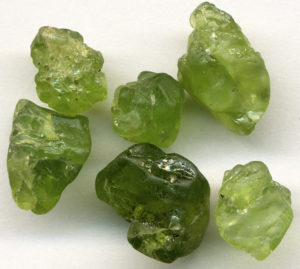
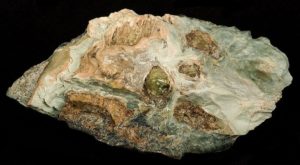
The two photos above show fresh olivine from Hawaii (Figure 4.46), and a single ancient olivine crystal (the green grain in the center of the specimen) from the Austrian Alps (Figure 4.47). Olivine was once abundant in many terrestrial Precambrian (older than 541 million years) mafic rocks, but since the Precambrian Era, most old olivine has been altered by oxygen, carbon dioxide, and water to make serpentine, iron oxides, and magnesite. Because olivine crystallizes in hot and dry magmas, it is unstable under much cooler and wetter Earth surface and near-surface conditions. Because of olivine’s and pyroxene’s tendency to weather rapidly, detrital olivine and pyroxene are largely restricted to relatively young (Cenozoic; younger than 65 million years old) sediments and sedimentary rocks. However, Precambrian olivine and pyroxene occur in Moon rocks and meteorites that have been isolated from oxygen and water.
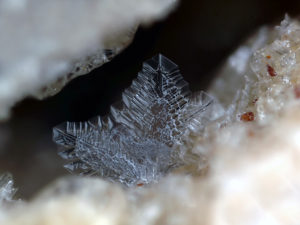
Other examples of minerals generally absent from older terrestrial rocks include the quartz polymorph tridymite, and aragonite, a high-pressure polymorph of calcite. Tridymite is common in Cenozoic siliceous volcanic rocks, including rhyolites, obsidian, and andesites. However, except in stony meteorites and lunar basalts, the mineral changes to quartz over time and is rarely found in rocks that are older than Cenozoic age. The photo in Figure 4.48 show snowflake tridymite in a volcanic rock in Germany.
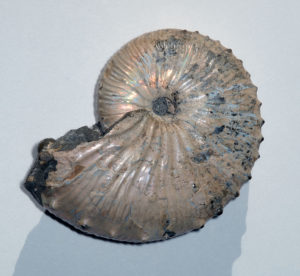
Many marine organisms create shells that consist of CaCO3 in the form of aragonite rather than calcite. Figure 4.49 shows an example. Unless aragonite fossils are deeply buried, they will alter to calcite. The oldest known aragonite fossil is from an organic-rich shale of Mississippian age (around 350 million years old). Geologists have only found aragonite fossils that old in three places. One of the rocks is volcanic while the others are black shale and asphaltic limestone. The presence of abundant organic matter in three of the four known rocks with Paleozoic aragonite is probably responsible for the preservation of the aragonite. The organic matter coated the fossils and probably prevented water from reaching them and promoting their conversion to calcite.
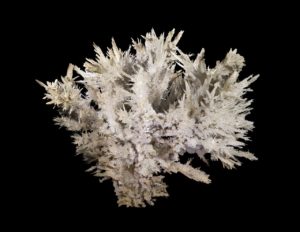
Inorganic aragonite sometimes forms on the ceilings or walls of caves or mines, in much the same way that stalactites and other speleothems form. It is, however, unstable, and over time turns into calcite. The change to calcite is slow, and occurs on time scales of 10 to 100 million years.
Some nonmineral materials are unstable and invert to minerals given a chance. Opal and volcanic glass are amorphous materials (although opal has been approved as a mineral name by the International Mineralogical Association). Over time, both weather or alter into more stable crystalline compounds, such as quartz. This explains why obsidian is rarely found in rocks older than the Miocene. The oldest known volcanic glass is in a 70-million-year-old welded tuff. Opal is slightly more stable than obsidian. Reaction rate calculations indicate that opal will entirely convert to quartz in about 180 million years at 20 °C , approximately 4.3 million years at 50 °C, and in only about 47 years at diagenetic temperatures of 200 °C. Not surprisingly, the oldest known opal is of Lower Cretaceous age, about 125 million years old.


